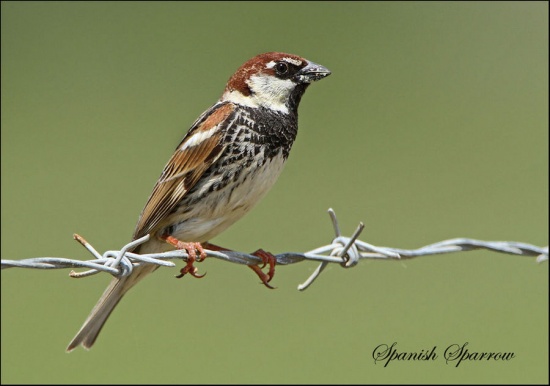Alternative name: Willow Sparrow
- Passer hispaniolensis
Identification
15 - 16cm
Male
- Bright chestnut crown
- Broad black bib meeting bold plack pattern on underside and black shoulders
- Whitish cheeks
- Narrow white supercilium
- Black on mantle and shoulders
Female
- Almost identical to female House Sparrow and usually impossible to separate
- Slightly bigger bill, paler belly and sometimes hint of grey streaking on whiter underparts
Juveniles are similar to females but duller.
Italiae (Italian Sparrow) is sometimes considered conspecific with this species. It has the same head pattern but less heavy black streaks on mantle and black only on upper breast.
Distribution
Breeds in western Spain, Portugal, Sardinia (Italy), northern Africa, the Canary Islands, Cape Verde Islands, Madeira, Balkans, Greece, Turkey, Cyprus, Israel and east to Iran, south Kazakhstan and northwest China.
Winters to the Arabian Peninsula and northwest India and Pakistan.
Italiae would breed in Italy, southern Switzerland, Corsica, Sicily and Crete.
Common to locally abundant.
Taxonomy

Photo by LECURU
Como, Italy, June 2006
Two subspecies recognized:
- P. h. hispaniolensis on the Iberian Peninsula, Sardinia, Greece and Balkans, western Turkey, the Canary Islands, Cape Verde Islands, Madeira and northwest Africa (Morocco, Algeria, Tunisia, northeast Libya)
- P. h. transcaspicus in Cyprus, eastern Turkey and the Middle East to Iran, Afghanistan, Kazakhstan and northwest China
The Italian Sparrow is sometimes regarded as subspecies of this species.
Forms a superspecies with House Sparrow and Italian Sparrow.
Habitat
Often in moist, humid areas near water and with trees and shrub. Associated with cultivated land and extends into urban areas where House Sparrow is lacking (eg. Canary Islands or Malta).
Behaviour
Feeds on seeds of grasses, cultivated crops ans low herbs. Takes also invertebrates. Nestlings are fed with insects.
Usually seen in flocks which may be very large.
Breeding season from April to August in the western parts of its range. A colonial breeder, sometimes with several thousand pairs. The nest is a loosely woven spherical structure made of grass and placed in a tree or in lower part of a large nest of a bird of prey, crow, heron or White Stork. Lays 2 - 6 eggs which are incubated for 12 days. The chicks fledge about 14 days old.
Resident in parts of its range, migratory or nomadic in others.
Vocalisation
<flashmp3>Passer hispaniolensis (song).mp3</flashmp3>
Listen in an external program
References
- Clements, JF. 2009. The Clements Checklist of Birds of the World. 6th ed., with updates to December 2009. Ithaca: Cornell Univ. Press. ISBN 978-0801445019.
- Del Hoyo, J, A Elliott, and D Christie, eds. 2009. Handbook of the Birds of the World. Volume 14: Bush-shrikes to Old World Sparrows. Barcelona: Lynx Edicions. ISBN 978-8496553507
- Rasmussen, PC and JC Anderton. 2005. Birds of South Asia: The Ripley Guide. Barcelona: Lynx Edicions. ISBN 978-8487334672
Recommended Citation
- BirdForum Opus contributors. (2024) Spanish Sparrow. In: BirdForum, the forum for wild birds and birding. Retrieved 30 April 2024 from https://www.birdforum.net/opus/Spanish_Sparrow
External Links





